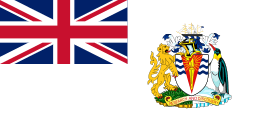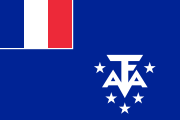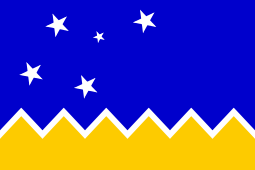Flag of Antarctica
Prior to 2002, Antarctica had no flag, as the condominium that governs the continent had not yet formally selected one (even though a particular design was in widespread use). The consultative members of the Antarctic Treaty System officially adopted a flag and emblem in 2002, which is now the official symbol of the continent.[1] Several unofficial designs have also been proposed.

Proposed designs
Several sources have suggested various designs, including one by Graham Bartram and one by Whitney Smith.
Graham Bartram
The Graham Bartram design uses the flag of the United Nations as its model. A plain white map of the continent on a blue background symbolizes neutrality (Bartram was well aware of the overlapping territorial claims of the United Kingdom, Chile, and Argentina when he designed the flag). This flag was actually flown on the Antarctic continent for the first time in 2002, when Ted Kaye (then editor of Raven, the scholarly journal of the North American Vexillological Association) took several full-size flags in the Bartram design on an Antarctic cruise. The bases of Brazil, Ukraine, and the UK all flew it from their flagpoles, making its raising "official". He presented a paper ("Flags Over Antarctica") which described the first flying of the Bartram design over Antarctica in Stockholm in 2003, at the 20th International Congress of Vexillology. The Graham Bartram design is used for the "Flag for Antarctica" Emoji (🇦🇶) on all supported platforms.[2]
Territorial flags
The nations of the Antarctic Treaty use their own national flags at their respective Antarctic research bases. Some nations however have their own flags for their Antarctic possessions.
British Antarctic Territory

The flag of the British Antarctic Territory is a plain White Ensign defaced by the Coat of Arms of the Territory. Other British territories in the Antarctic region are the Falkland Islands and South Georgia and the South Sandwich Islands, which have their own flags (see Flag of the Falkland Islands and Flag of South Georgia and the South Sandwich Islands).
French Southern and Antarctic Territories

The flag of the French Southern and Antarctic Territories, which includes Adélie Land, has the French tricolor in the canton together with the Commissioner's logotype. The logotype consists of five stars and the letters "TAAF" in a monogram (from the French name of the territory, Terres australes et antarctiques françaises). The flag was adopted on 23 February 2007, and was published in the Official Journal of the French Southern and Antarctic Territories on March 15, 2007.[3]
Argentine Antarctica

The Argentine province of Tierra del Fuego includes Argentine Antarctica (25 degrees W to 74 degrees W). The flag was adopted in 1999 as the result of a competition. It is a diagonal bicolor of sky blue and orange with an albatross in the center and the Southern Cross in the fly.
Chilean Antarctic Territory/Magallanes Region

The Antártica Chilena Province in the Magallanes Region includes the Chilean claim on the continent (53 degrees W to 90 degrees W). Puerto Williams is the capital of this province, which also includes the islands south of Tierra del Fuego and Cape Horn. The Magallanes Region's flag also has the Southern Cross appearing over a mountain range. This flag was adopted as the flag of Magallanes Region in 1997 by the regional government.[4]
Ross Dependency
Currently, only the New Zealand national flag serves in an official capacity in the Ross Dependency. The only other 'official' flag seen in photographs was the New Zealand Post flag to denote Scott Base's post office.
Ross Dependency (New Zealand's territorial claim in Antarctica) uses the New Zealand flag, but vexillologist James Dignan's design concept was seen flying there at one time (when a friend of Dignan took it with him to Vanda Station in 1994). The New Zealand flag is the basis for his design, though with an 'Ice Blue' background representing the Ross Sea, and the white horizontal bar at the bottom of the flag representing the Ross Ice Shelf.[5]
References
- "Decision 2 (2002) - ATCM XXV - CEP V, Warsaw". Secretariat of the Antarctic Treaty. 20 September 2002. Archived from the original on 23 September 2015. Retrieved 7 April 2019.
- "Flag for Antarctica Emoji". Emojipedia. Retrieved December 13, 2017.
- Perillo, Thierry (1 January 2008). "Le drapeau des TAAF (valeur d'appoint)". Philatelie des TAAF (in French). Archived from the original on 18 April 2010. Retrieved 7 April 2019.
- Cerda Sepúlveda, Manuel (5 February 1997). Salles González, Ricardo (ed.). "Resolution N° 42 about the Regional Symbols of Magallanes". Biblioteca del Congreso Nacional de Chile (in Spanish). Retrieved 7 April 2019.
- Dignan, James (21 November 1995). "Ross Dependency". www.flagcentre.com.au. Archived from the original on 13 April 2018. Retrieved 13 April 2018.
.svg.png)
.svg.png)
.svg.png)
